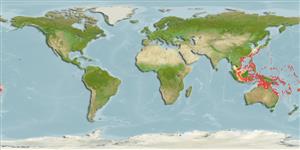Common names from other countries
Environment: milieu / climate zone / depth range / distribution range
Écologie
; profondeur 8 - 65 m (Ref. 101224). Tropical
Distribution
Pays | Zones FAO | Écosystèmes | Occurrences | Introductions
Western Central Pacific: New Caledonia, Guam and Singapore.
Length at first maturity / Taille / Poids / Âge
Maturity: Lm ? range ? - ? cm
Inhabits wave exposed rocky shores. Feeds on epilithic algae by grazing (Ref. 85382).
Life cycle and mating behavior
Maturité | Reproduction | Frai | Œufs | Fécondité | Larves
Members of the order Patellogastropoda are mostly gonochoric and broadcast spawners. Life cycle: Embryos develop into planktonic trocophore larvae and later into juvenile veligers before becoming fully grown adults.
Smith, B.D. 2003. (Ref. 3116)
Statut dans la liste rouge de l'IUCN (Ref. 130435)
statut CITES (Ref. 108899)
Not Evaluated
Not Evaluated
Utilisations par l'homme
| FishSource |
Outils
Plus d'informations
Taille/Âge
Croissance
Longueur-poids
Longueur-longueur
Morphologie
Larves
Abondance
Sources Internet
Estimates based on models
Preferred temperature
(Ref.
115969): 24.8 - 29, mean 28 (based on 650 cells).
